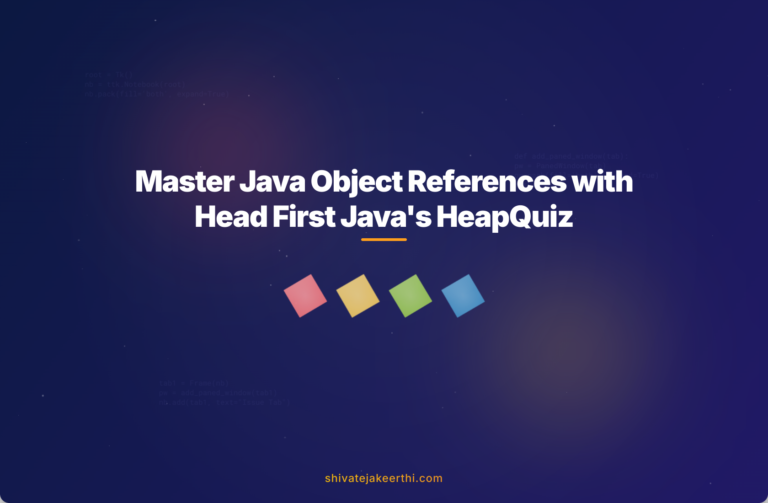If you’ve read “Head First Java,” you’ve probably come across some engaging examples that explain complex ideas simply. One such scenario is the HeapQuiz example—a Java snippet designed to clarify how Java object references work. Yet, many beginners get confused about exactly how reference variables point to object IDs. Let’s clear this confusion by exploring how Java object references function, using the HeapQuiz example as our guide.
Understanding Java’s object references requires grasping the concept of variables that “point” to objects. In Java, you have two broad types of variables: primitive variables (like int, char, boolean) and reference variables. Primitive variables directly store value data, whereas reference variables store memory addresses (pointer-like values) of objects residing in the heap.
Imagine reference variables as remote controllers for televisions. The remote itself doesn’t display images or sounds—the television does. Similarly, a reference variable itself contains no meaningful application data, just directions to the heap where actual object data is stored. Understanding this distinction makes managing Java references easier.
Each time you use the Java keyword new, Java creates an object on the heap—a special area in your computer’s memory where objects live. The reference variable then stores the object’s memory address (imagine a street address for an object house), effectively pointing to the location.
In the HeapQuiz example from Head First Java, we see how multiple reference variables and objects interplay:
Take a look at the code snippet:
class HeapQuiz {
int id = 0;
public static void main(String[] args) {
int x = 0;
HeapQuiz[] hq = new HeapQuiz[5];
while (x < 3) {
hq[x] = new HeapQuiz();
hq[x].id = x;
x = x + 1;
}
hq[3] = hq[1];
hq[4] = hq[1];
hq[3] = null;
hq[4] = hq[0];
hq[0] = hq[3];
hq[3] = hq[2];
hq[2] = hq[0];
}
}
Let's analyze what this code is actually doing step by step:
Initially, an array named hq of type HeapQuiz is created, capable of storing five references to HeapQuiz objects. Next, a loop runs three times (for values of x from 0 to 2), creating new HeapQuiz objects and storing their references in the hq array. Each object gets a unique 'id' set to the value of x at the moment it's created.
Think of these initial objects as three separate houses built in your neighborhood, each given a house number (id) 0, 1, and 2.
After the loop completes, the array hq has objects at positions 0, 1, and 2. Let's say their object IDs (memory addresses) are generated by Java as numbers like "#345," "#789," and "#876" respectively (just hypothetical addresses for explanation purposes).
Next, the reference assignments begin to shuffle. Here's the breakdown:
- hq[3] = hq[1]; — Makes the reference variable at position 3 point to the same object hq[1] points to (#789).
- hq[4] = hq[1]; — Now, position 4 also points to object #789.
- hq[3] = null; — Clears this specific reference variable. hq[3] is now pointing nowhere.
- hq[4] = hq[0]; — Changes position 4 from pointing to #789, to now point at the first object (#345).
- hq[0] = hq[3]; — Since hq[3] is null, hq[0] now also refers to nothing.
- hq[3] = hq[2]; — variable 3, which was null, now points to object #876 (originally at hq[2]).
- hq[2] = hq[0]; — Since hq[0] is null, hq[2] loses its reference and also points to nothing.
After execution, some references become null (point nowhere), and some change from pointing to one object to another. The important thing? Underlying objects themselves don't move around—only the references change. It's like rearranging TV remote controllers—the TVs remain fixed where they're plugged in; you just change which remote controls which TV.
Now let's clarify which variables end up pointing to which objects after all these assignment sequences:
- hq[0]: null (points nowhere)
- hq[1]: object #789 (created when x was 1)
- hq[2]: null (no longer points anywhere)
- hq[3]: object #876 (originally hq[2])
- hq[4]: object #345 (originally hq[0])
To summarize the confusion clearly—reference variables are just pointers. Different references might point to the same object, and references can point to nothing (null). When you assign one reference to another, you're creating multiple references to one object, not copying or duplicating the object itself.
It's important because Java's garbage collection (removal of unused objects in memory) depends solely on references. If an object has no references pointing to it, Java's garbage collector reclaims its memory, maintaining your program's efficiency.
Many beginners stumble upon Java references because they confuse the concept with primitive assignments. But primitives store real values ([intA=5; intB=intA]; means each variable separately holds a value of 5), while references share access to single objects.
Ultimately, mastering references is crucial in Java programming. Efficient heap management, memory conservation, and optimized programs directly depend on clear understanding and proper handling of object references. This understanding also aids in preventing common Java-related errors (NullPointerException anyone?).
JavaScript also has reference concepts, though handled differently—if you're interested, here's a guide comparing Java and JavaScript.
Feeling more confident about Java object references now? Experiment further by creating your own HeapQuiz-like scenarios. Tweak assignments, add extra objects, and observe how references behave.
And remember, consistent practice and experimentation accelerate your learning curve dramatically—so get coding!
What's your next Java project? Are you ready to confidently manage object references?



0 Comments